NATO Nuclear Weapons Exercise Over Southern Europe
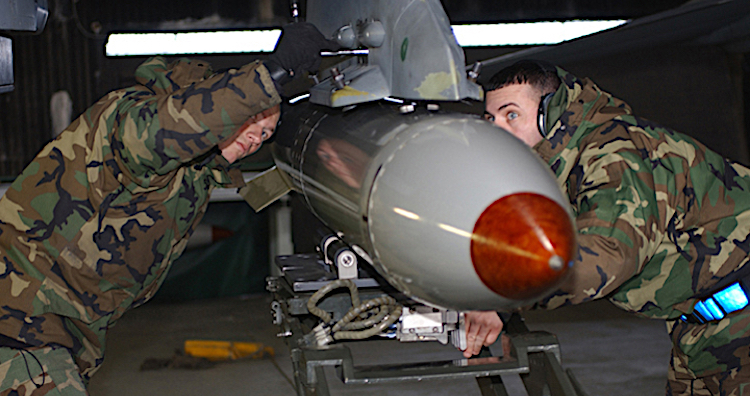
USAF personnel loading a B61 nuclear bomb trainer on an F-16 fighter-bomber at Aviano Air Base
NATO announced Monday that it had started its annual nuclear exercise code-named Steadfast Noon. The week-long exercise is taking place over Southern Europe and involves aircraft and personnel from 14 NATO countries.
According to the NATO statement, “Steadfast Noon involves training flights with dual-capable fighter jets, as well as conventional jets, backed by surveillance and refuelling aircraft. No live weapons are used. This exercise helps to ensure that NATO’s nuclear deterrent remains safe, secure and effective.”
The nuclear bases in southern Europe have received several upgrades during the past few years. This includes adding additional security perimeters to strengthen protection of the nuclear weapons stored at the bases. Two of these bases – Aviano in northeast Italy and Incirlik in southern Turkey, were upgraded over the past five years.
The second nuclear base in Italy – Ghedi near Brescia – that might be part of Italy’s hosting of this year’s Steadfast Noon exercise, is currently undergoing several important nuclear weapons related modernizations that are intended to serve the NATO nuclear strike mission for years.
Of the 14 nations involved, Dutch F-16s and German Tornadoes are operating out of Ghedi AB alongside Italian Tornados, while U.S. and Belgian F-16s and possibly Czech Gripen are operating out of Aviano AB.

The Steadfast Noon exercise appears to involve operations out of both Ghedi AB and Aviano AB
The timing of the Steadfast Noon exercise coincides with the meeting of the NATO ministers of defense later this week, although it is unclear if the timing is coincidental. NATO has greatly reduced (as has Russia) the number of non-strategic nuclear weapons in Europe since the Cold War. The remaining weapons were probably headed for withdrawal had it not been for Russia’s invasion of Ukraine in 2014. And with claims that Russia is increasing its non-strategic nuclear arsenal, NATO has since reemphasized the importance of the U.S. tactical nuclear weapons in Europe. During the Steadfast Noon exercise at Volkel Air Base in 2020, for example, the NATO Secretary General showed up at the base for a photo-op.
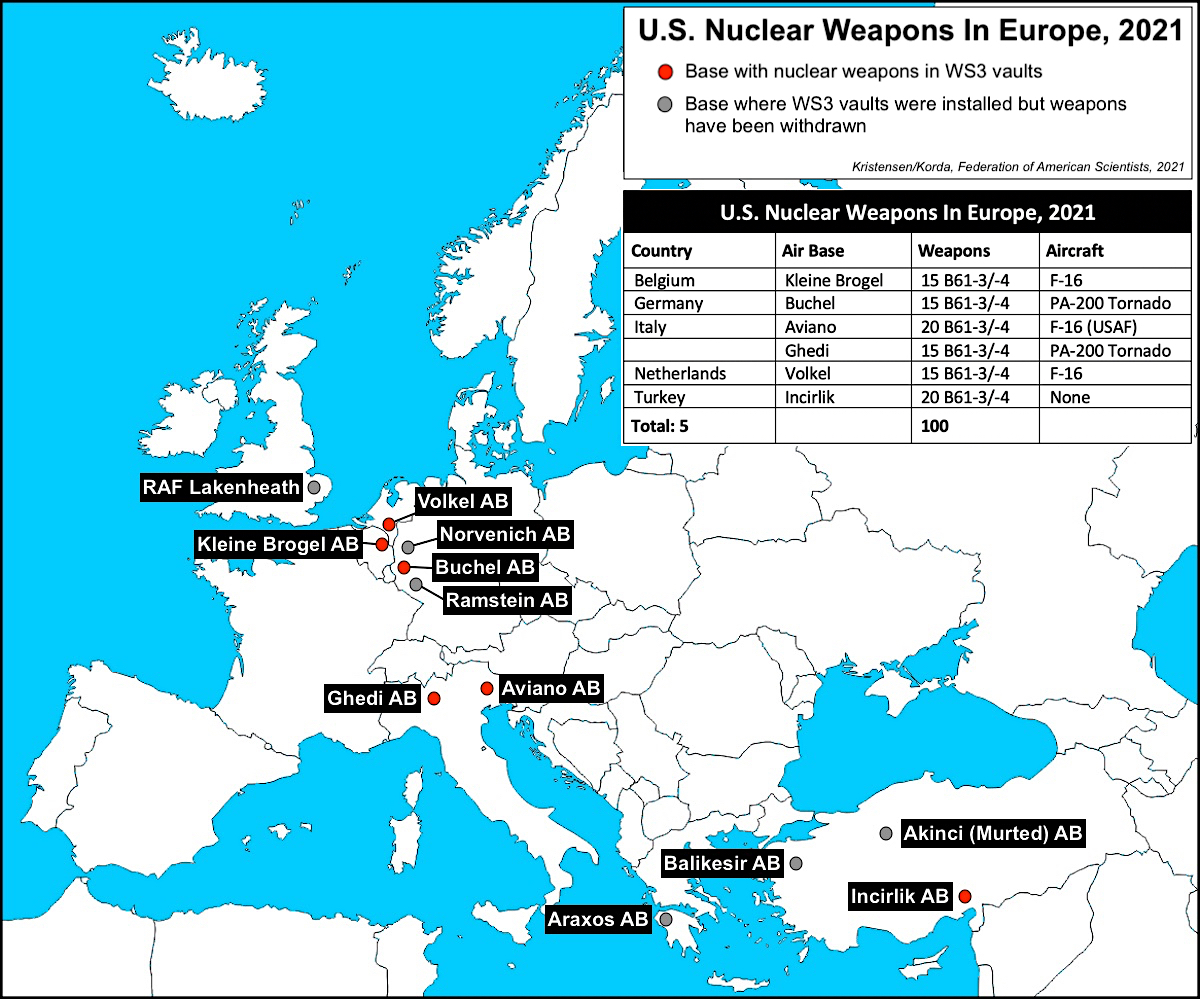
The USAF currently stores an estimated 100 nuclear bombs in Europe, down from 180 in 2010 and 480 in 2000. Over the past decade, restructuring and uncertainty about Turkey have reduced the inventory.
Ghedi: Nuclear Base Profile
NATO announced the Steadfast Noon is taking place over southern Europe but did not identify the main operating base. Steadfast Noon exercises are hosted by a different country each year. Last year it was hosted by the Netherlands and centered at Volkel AB. The reference to southern Europe implies this year’s Steadfast Noon is hosted by Italy and probably centered at Ghedi AB and Aviano AB is northern Italy (Aviano hosted in 2010 and 2013).
Ghedi AB is home to the Italian Air Force’s 6th Stormo wing, which is tasked to employ U.S. B61 bombs with PA-200 Tornado of the 102nd and 154th fighter-bomber squadrons. There are an estimated 15 B61 bombs stored in underground vaults at the base. The bombs are in the custody of the USAF’s 704th Munition Support Squadron (MUNSS), a 130-personnel strong security and maintenance unit embedded at the base.
Ghedi AB is currently undergoing significant upgrades to receive the new F-35A fighter-bomber next year, installing double-fence security perimeters, and having recently completed modernizing the Weapon Storage and Security System (WS3) and Alarm Communication and Display (AC&D) system. The contract for the WS3/AC&D work, which was awarded in September 2016, provided for sustainment upgrades to the WS3 cryptographic system used to encrypt WS3 alarm data, and will perform an AC&D system upgrade by replacing obsolete components and the buried cable. These upgrades are clearly visible on satellite images, as are a new “bunker building” under construction in the 704th MUNSS area along with the new Secure Transportation and Maintenance System (STMS) trucks (see images below).
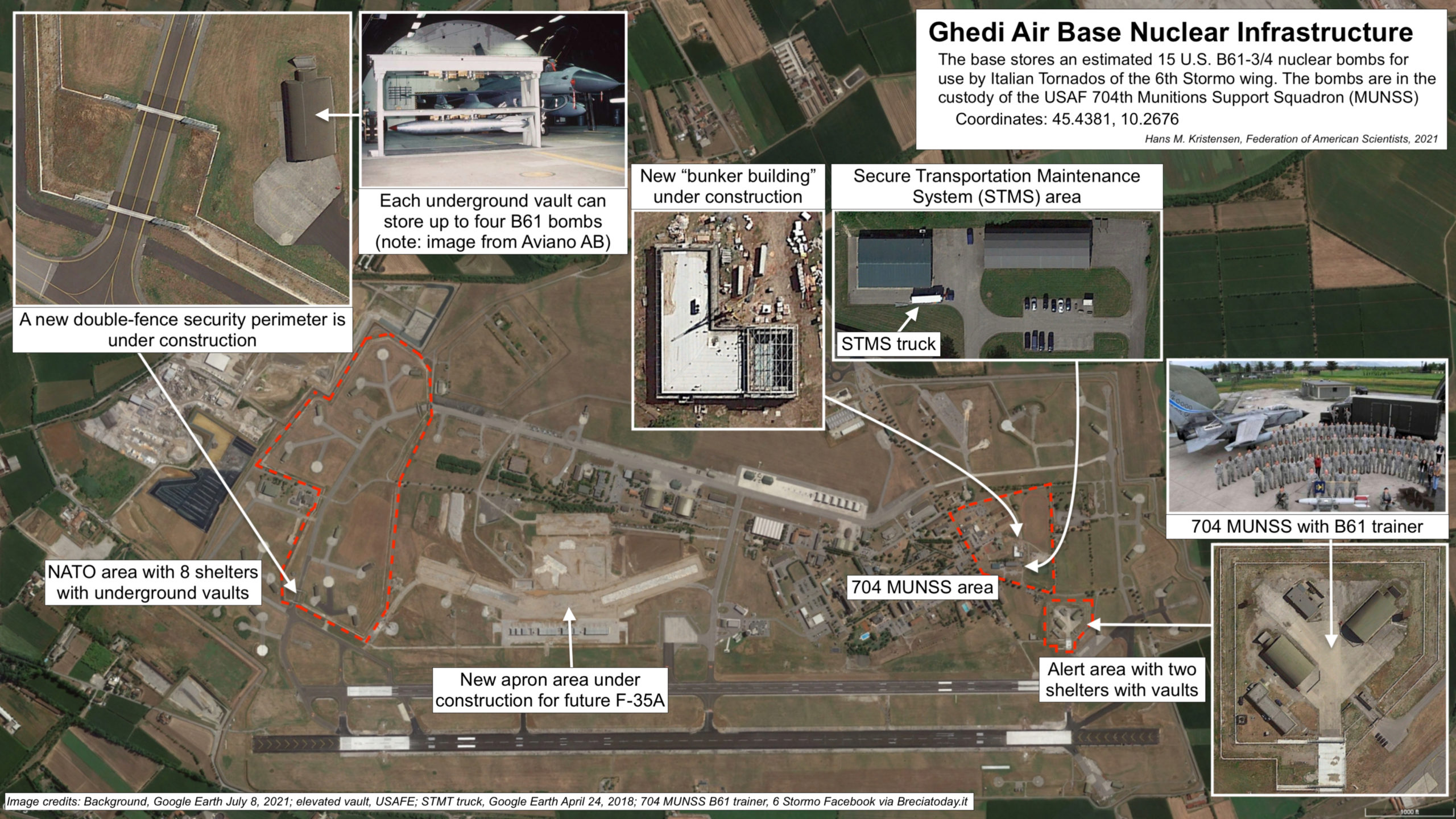
Several nuclear weapons related upgrades are underway at Ghedi Air Base.
The new double-fence security perimeters around eight protective aircraft shelters (left side of image) as well as the former nuclear alert area (lower right side) are similar to the security upgrades previously completed at two other bases in southern Europe: Aviano and Incirlik air bases. The area inside the perimeters is commonly referred to as the NATO area, a reference to the NATO nuclear strike mission they support. In the 1990s, NATO installed a total of 11 underground vaults inside 11 protective aircraft shelters at Ghedi AB. Each vault can store up to four B61 bombs (normally only one or two bombs are present).
But there’s a mystery: The new security perimeters only surround 10 of the 11 shelters. One possibility is that the remaining vault in the 11th shelter is a training vault, or that the number of active vaults has been reduced. But a satellite image from April 2018 might provide a hint. The image appears to show the markings from the burying of the new AC&D cables that connect the vaults in the shelters with the monitoring and communications facilities at the base. By retracing the cables markings, a pattern emerges: the cables appear to connect exactly 11 shelters, including seven inside the new security perimeter. Moreover, the cables appear to form two loops, possibly so that damage to a cable in one spot won’t cut off communication with the vaults on the other side (see image below).
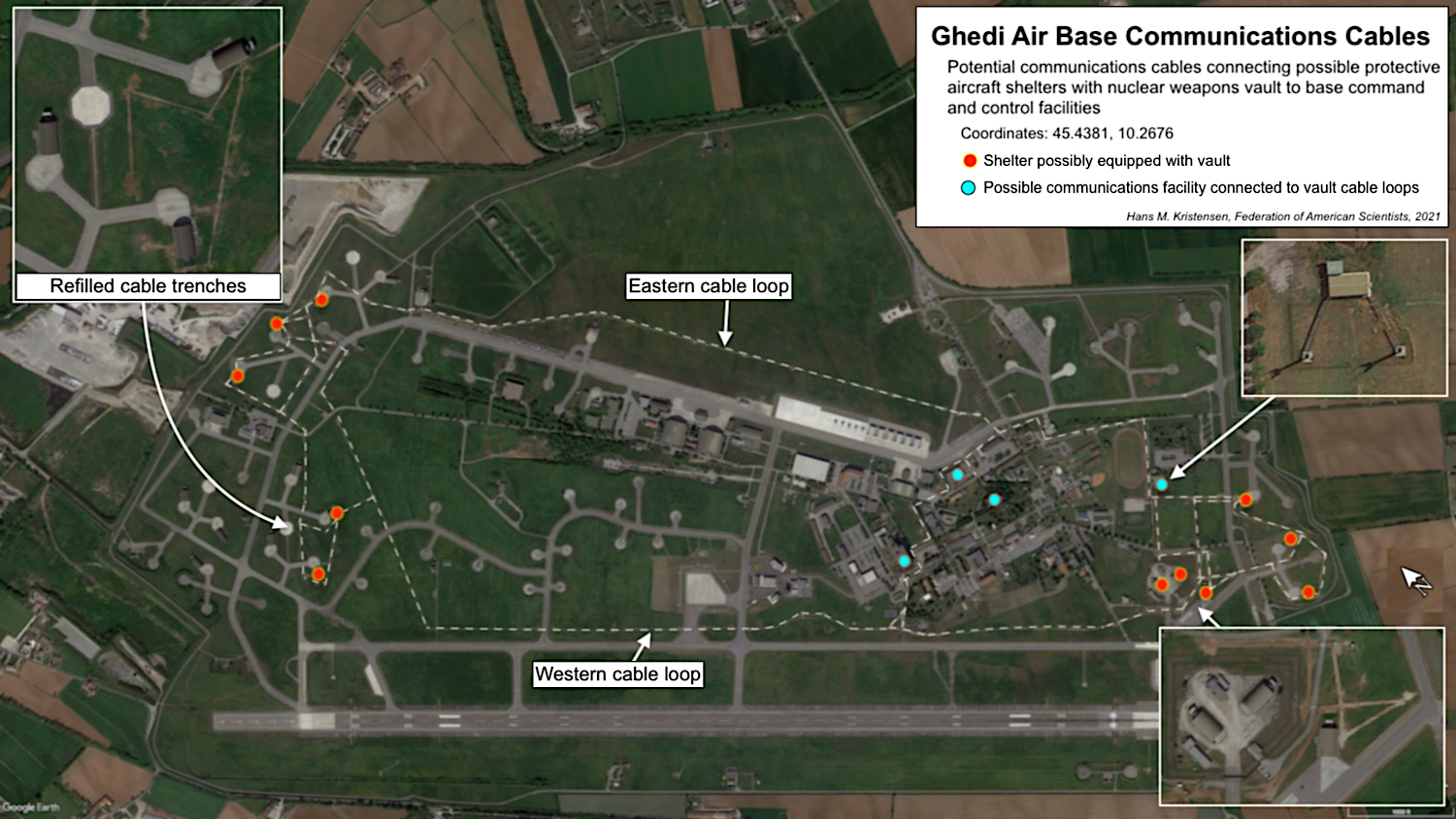
A satellite image appears to show which shelters are connected to the nuclear command and control system at Ghedi Air Base. Image: Google Earth, April 24, 2018.
There is another mystery: Several shelters connected to the apparent AC&D cable grid are located outside the new security perimeters (right side of image), and several shelter that do not appear to be connect to the grid are inside the perimeter (left side of image). Since survivability was one of the justifications for building vaults instead of a central weapons storage area, it would make sense that vaults would be scattered across the base. But the 11 vaults were completed at a time when there were many more nuclear bombs stored at Ghedi AB than today: over 40 bombs in 2000 compared with about 15 bombs today.
Perhaps the four vaults outside the perimeters are backup vaults that do not contain bombs under normal circumstances. All remaining weapons would be stored in the seven vaults inside the perimeters under normal circumstances. With a capability to store up to four B61 bombs each, even the five vaults inside the main security perimeter have more than enough capacity to store the 15 bombs currently estimated to be located at Ghedi AB.
Weapons And Capabilities
These upgrades at Ghedi AB are intended to support the NATO nuclear strike mission at the base for decades into the future. The F-35A, which will begin arriving at the base probably as early as in 2022, is significantly more capable than the Tornado aircraft it replaces.
Moreover, the B61-12 gravity bomb is about three times as accurate as the B61-3/-4 bombs current stored at the base. The increased accuracy is achieved with a new guided tail kit that will enable strike planners to hold at risk targets more effectively with the B61-12 than with the current B61 versions. Like the B61s currently at the base, the B61-12 is thought to have four selectable yield settings ranging from less than 1 kilotons to about 50 kilotons. But with the increased accuracy, a strike planner would be able to select a lower yield option for the attack and therefore create less radioactive fallout, or attack targets that currently require a higher-yield strategic bomb from a B-2 bomber.
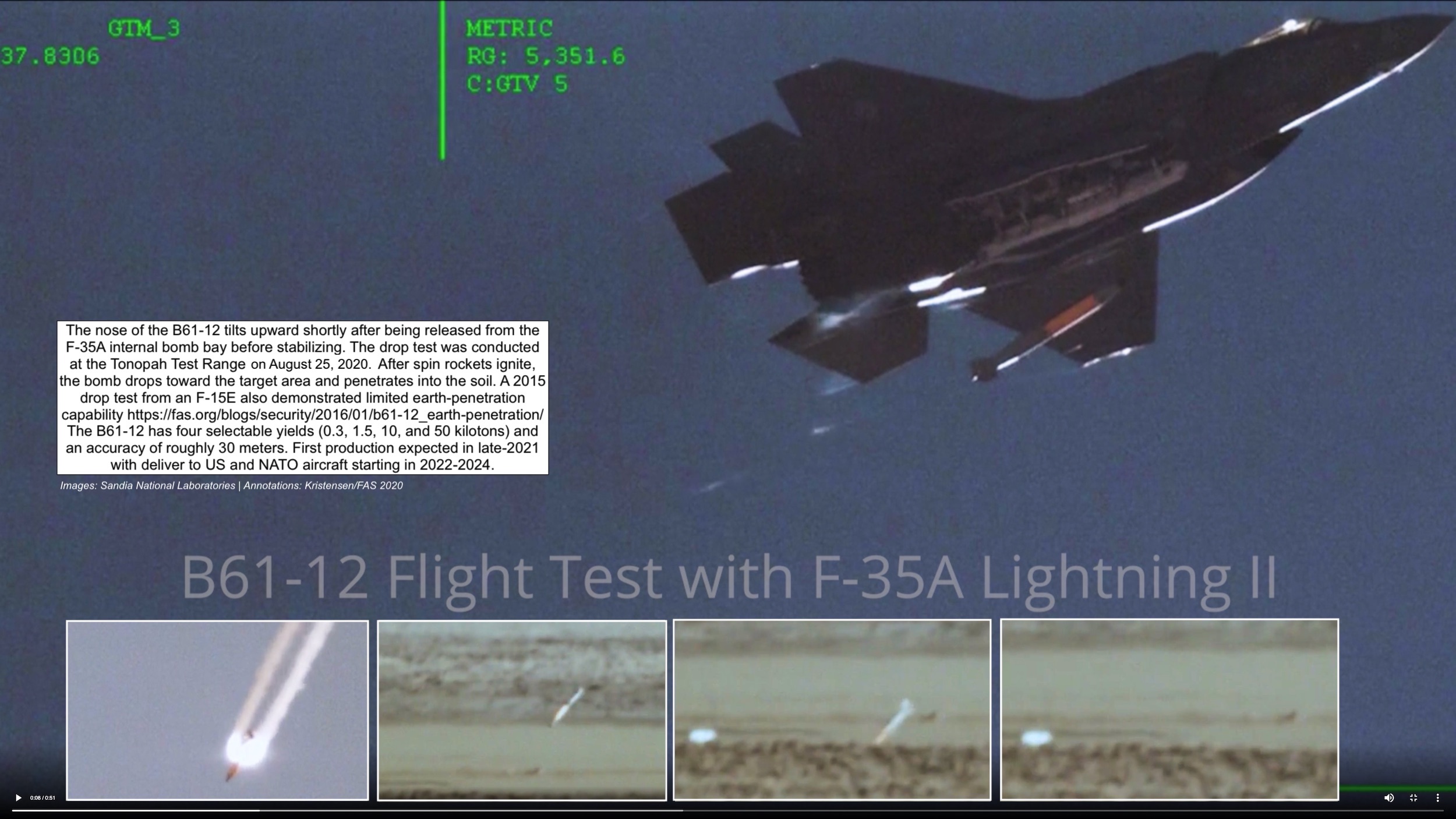
The F-35A with the B61-12 “brings an entirely new strategic-level capability.”
The combination of the F-35A and B61-12 represent a significant improvement of the military capability of the NATO dual-capable aircraft posture in Europe. Following the final drop test from an F-35A in a few weeks ago, for example, the chief of the U.S. Air Force Air Combat Command’s strategic deterrence and nuclear integration division, Lt. Col Daniel Jackson, said that “Having a 5th Generation DCA fighter aircraft with this capability brings an entirely new strategic-level capability.” He explained further: “The B-2 bomber was the prominent nuclear capable stealth aircraft, but “Adding ‘nuclear capable’ to a 5th-Gen fighter that already brings several conventional-level capabilities to the table adds strategic-level implication to this jet.”
Additional information:
- United States Nuclear Weapons, 2021
- Tactical nuclear weapons, 2019
- Video Shows Earth-Penetrating Capability of B61-12 Nuclear Bomb
- Upgrades at US Nuclear Bases in Europe Acknowledge Security Risk
This publication was made possible by generous support from the John D. and Catherine T. MacArthur Foundation, the New Land Foundation, the Ploughshares Fund, and the Prospect Hill Foundation. The statements made and views expressed are solely the responsibility of the author.
The FY2026 National Defense Authorization Act (NDAA) paints a picture of a Congress that is working to both protect and accelerate nuclear modernization programs while simultaneously lacking trust in the Pentagon and the Department of Energy to execute them.
While advanced Chinese language proficiency and cultural familiarity remain irreplaceable skills, they are neither necessary nor sufficient for successful open-source analysis on China’s nuclear forces.
Satellite imagery has long served as a tool for observing on-the-ground activity worldwide, and offers especially valuable insights into the operation, development, and physical features related to nuclear technology.
This report outlines a framework relying on “Cooperative Technical Means” for effective arms control verification based on remote sensing, avoiding on-site inspections but maintaining a level of transparency that allows for immediate detection of changes in nuclear posture or a significant build-up above agreed limits.